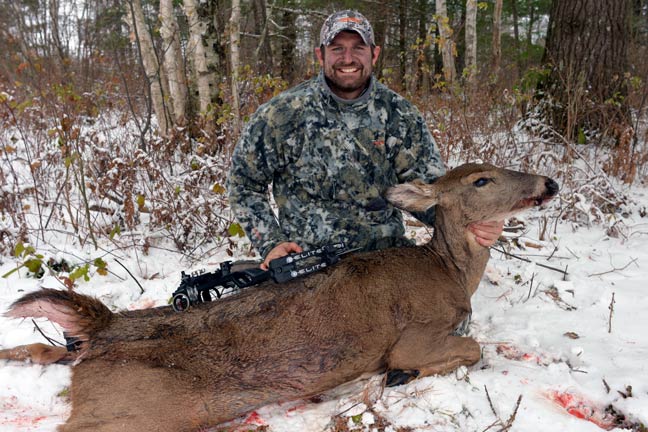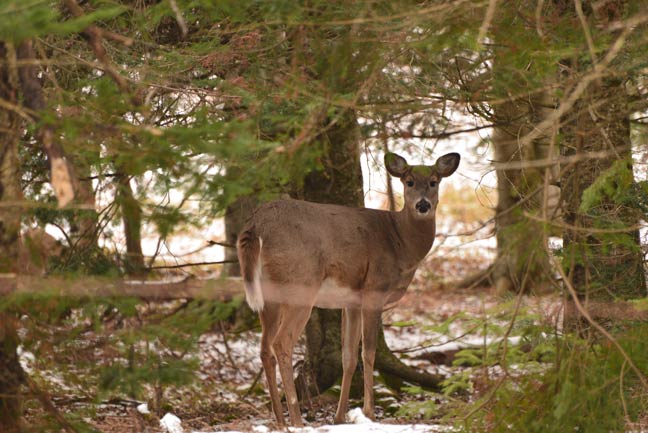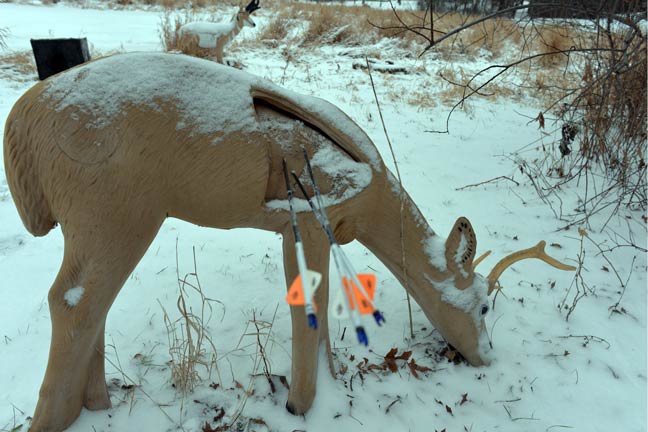Bowhunting specifically for does is something that sounds so easy. After all, there are a pile of ladies in the woods and one doe is just as good as the next, so it shouldn’t be terribly difficult. But it oftentimes is — especially in the last weeks of the season.

Putting that last antlerless deer of the season into the freezer should be easy, but often isn’t.
The deer that are left are survivors and they don’t tolerate much in the way of sloppiness. Granted, if you’ve got a killer property that is locked up tight and you can sit over a lush food source, you probably won’t encounter as much trouble in completing a venison mission. The rest of us, biding our time on public ground or heavily-hunted private, don’t have it so easy.
Mature does, right now, are far from pushovers and they demand an attention to detail. They are certainly killable, but you’ll need to do nearly everything right. Here’s how.
Play The Buffet Correctly
I don’t know how many deer-hunting experts have touted the advice that late-season bowhunters should sit on a food source and wait out hungry cervids. It’s pretty hard to be wrong offering up such a simple strategy, but it falls far short of being really useful.
I don’t know how many deer-hunting experts have touted the advice that late-season bowhunters should sit on a food source and wait out hungry cervids. It’s pretty hard to be wrong offering up such a simple strategy, but it falls far short of being really useful.
You do need to factor in destination food sources, because they matter. But killing any deer on them if they’ve been hunted hard for nearly a full season isn’t going to happen most of the time. The days right now are short and the nights are long. This is a major advantage for the deer. They can, and often do, wait out the darkness before heading out to feed. Then, if you’re perched at the edge of a field, you’ll most likely spook them as you get down and the worst part is, you might not even know it.
Can you kill does on food sources, of course. But what if you don’t?
Where They’re Vulnerable
The space between where deer bed and fill their bellies is a far more reliable spot to arrow a doe. Some of these spots are staging areas, but others are simply travel routes from point A to B. What they all have in common is that they’ll be areas where the deer will move during daylight. That matters.
The space between where deer bed and fill their bellies is a far more reliable spot to arrow a doe. Some of these spots are staging areas, but others are simply travel routes from point A to B. What they all have in common is that they’ll be areas where the deer will move during daylight. That matters.
The next, and most important step in the process is setting up an ambush that you can get to quietly. And without the wind betraying your presence. And that lets you get drawn on a cagey deer in the pin-drop quiet woods of early winter. See, easy right?
The Setup
I recently spent several days hunting public land in northern Wisconsin. While I was hunting for a buck, I also focused on putting a doe in the freezer. I did not anticipate too many problems doing this.
I recently spent several days hunting public land in northern Wisconsin. While I was hunting for a buck, I also focused on putting a doe in the freezer. I did not anticipate too many problems doing this.

The best spot to arrow a late-season doe is in a staging area or along a travel route that relates to the nearest destination food source.
The first doe that approached gave me a perfect 15-yard shot from my freshly hung portable. She didn’t even let me get through half of my draw cycle before high-tailing it back into the alders. For my second attempt, I used a climbing stand to get up maybe 20 feet, which I assumed would be plenty high enough. It wasn’t. She didn’t even let me start to draw before taking off.
The third time, I buried a portable in a clump of trees that was surrounded by cover and would allow me to draw really early. This I did, and she still busted me at full draw up in my tree. Unfortunately for her, when she pegged me she had already stepped into my shooting lane.
Hang your stands high, brush them in, and if you can, face them directly away from where the deer should approach from. I’m to the point now where I’d rather be 25 yards from the deer than 10, so consider shot distance and anticipate that no matter how ninja-like you move and draw, you’ll probably get busted unless you get your movements out of the way while the deer are still quite a ways from your stand. Anticipate all possible ways to get busted, and try to set your ambush to avoid as many as you can.
Pre-Hunt Groupings
Very, very few bowhunters practice enough in the late-season. This is a mistake. I tend to set up a target specifically so I can shoot just a couple of arrows before I head out for an evening hunt. This allows me to shoot with most, or all, of my bulky clothes on.
Very, very few bowhunters practice enough in the late-season. This is a mistake. I tend to set up a target specifically so I can shoot just a couple of arrows before I head out for an evening hunt. This allows me to shoot with most, or all, of my bulky clothes on.

After suiting up but before heading out for a late-season sit, take a few shots to make sure everything is as it should be with your bow.
This step provides a boost of confidence if everything goes right, and valuable clues if something goes wrong. Just make sure to set up the easiest-to-shoot scenario as possible so you will, in fact, shoot.
The Sit
The key to all-things-late-season is comfort. You’ll need layers of clothing that allow for a three-hour sit. If you get cold, it’s over. I used to think chemical handwarmers were for lesser men than I, but I’ve outgrown that chest-thumping idiocy. I now think they are amazing, and I use them for every December hunt.
I don’t want to suffer unnecessarily when I’m doing something I should enjoy, and neither should you.
The key to all-things-late-season is comfort. You’ll need layers of clothing that allow for a three-hour sit. If you get cold, it’s over. I used to think chemical handwarmers were for lesser men than I, but I’ve outgrown that chest-thumping idiocy. I now think they are amazing, and I use them for every December hunt.
I don’t want to suffer unnecessarily when I’m doing something I should enjoy, and neither should you.
Take the right steps to be comfortable on stand, and you’ll realize all of the other steps you’ve taken were worth it. Especially when you see an old, long-nosed matriarch picking her way down the trail and you know the wind is right, she’s not going to spot you, and the shot should go off without a hitch.
Read more: http://www.bowhunter.com/tactics/late-season/5-steps-to-outsmart-late-season-does/#ixzz50PTp6zdz

No comments:
Post a Comment